Amsterdam
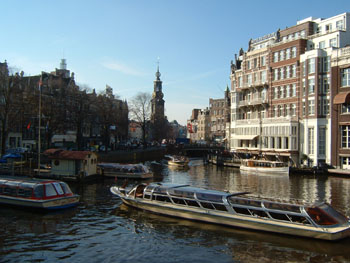
To begin this brief account, I'd like to take advantage of the sensitive times in which we live to suggest a bit of vocabulary modification. Amsterdam is the principal city of a nation called Nederland, where the local language is Nederlands. Although Nederlands is full of sounds that are difficult for English-speakers to reproduce, the word 'Nederlands' is not one of them. 'Dutch' (say goodbye) is a corruption of the Dutch (bye) word for 'German,' Duits.
In other words, to say that I had a good time in Amsterdam would be severe understatement.
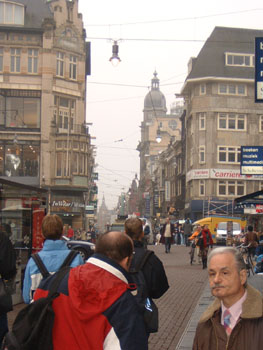
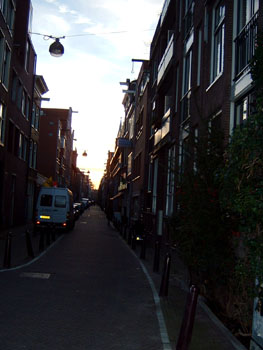 Kathleen
found the trams somewhat disconcerting; we decided that I didn't because I'd
grown up in the suburbs, and was used to the mixed use of pavement. The trams
rumble along in an agreeable way that's unlikely to take anyone by surprise,
and, besides, the drivers have jolly bells to ring. We could have saved hours by
making use of the trams, but we weren't quite up to the fare strip system, which
all the guidebooks made sound too complicated, and besides, Amsterdam
is a great city for walking.
Kathleen
found the trams somewhat disconcerting; we decided that I didn't because I'd
grown up in the suburbs, and was used to the mixed use of pavement. The trams
rumble along in an agreeable way that's unlikely to take anyone by surprise,
and, besides, the drivers have jolly bells to ring. We could have saved hours by
making use of the trams, but we weren't quite up to the fare strip system, which
all the guidebooks made sound too complicated, and besides, Amsterdam
is a great city for walking.
Here's what we were told by a jeweler on the Rokin: if you're not proficient
in English, you don't graduate from high school in Nederland. On the evidence, I
see no reason to doubt this. Everyone spoke English to me. It's true that
everyone tried Nederlands first, and I was mortified not to be able to reply in
kind. After a week of listening to the radio and watching TV after dinner, I was
just beginning to understand the odd sentence. (That I could figure out most
headlines wasn't much help when it came to listening comprehension.) I vowed to
spend a weekend at Berlitz before my next trip. But whether or not I can make my
way in Nederlands is not the point. The point is that proficiency in English has
not caused the people of Nederland to forsake their native tongue. It has not
stemmed the translation of foreign literature. True, Donna Tartt's The Little
Friend was available in English, but it had been published in Nederlands
first (even before it appeared in the United States), owing to the enormous
popularity of De Verborgen Geschiedenis ten-odd years ago. Jonathan
Franzen's Die Correcties was piled high at Scheltema, as was Ian McEwan's
Boetekleed (Atonement). The sound of Amsterdam convinced me both
that English is probably never going to be most people's first language, and
that English-speakers 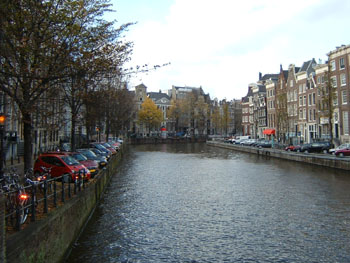 will be the poorer for not needing a strong second
language.
will be the poorer for not needing a strong second
language.
I didn't take a picture of the Café Luxembourg, but I ate there often enough. It's on the Spui ('sluice'), an open space that on Fridays is given over to a book fair, and Amsterdam's 'serious' bookshop, Athenaeum Boekhandel, is practically next-door. We ate very well in Amsterdam, and very reasonably, too - but then we were coming from Manhattan, than which only London is said to be more expensive. I would recommend the two gala restaurants that we tried, De Vijf Vliegghen and De Tuinhuis (which does not mean 'townhouse'), very highly. But for a perfect burger, a club sandwich, or shrimp croquettes, with a bottle of wine, comfy banquettes, and the hazy, chattering atmosphere that has been outlawed in New York, the Café Luxembourg couldn't be beat. It is, according to one restaurant guide, a publishing hangout, and when a friend wrote to ask if I was having a lot of interesting conversation in cafés, I had to ask myself, why not?
Why not? First of all, New Yorkers don't talk to strangers. It's a matter of
politeness, not prudence. In New York, it can be taken for granted that anyone
not currently engaged in conversation is silent by choice. More than that, as I
realized when I asked myself the question, the last thing I wanted to get
involved with was the kind of political discussion that my being an American
might easily ignite. I couldn't begin to defend the current Administration's
policies, but I didn't really want to spend any time apologizing for them,
either. I couldn't plausibly pass 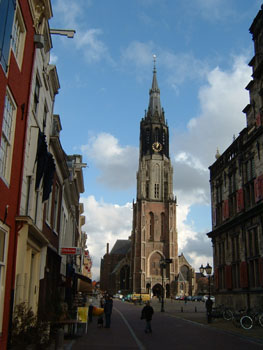 myself off as Canadian. Part of the appeal of
the trip was to leave home. Next time, at any rate, I hope to be
able to eavesdrop on interesting café conversations.
myself off as Canadian. Part of the appeal of
the trip was to leave home. Next time, at any rate, I hope to be
able to eavesdrop on interesting café conversations.
On our last day, we took the train to Delft. It was a Monday, and everything was closed except for the two famous churches. The Nieuwe Kerk, right, has been associated with the House of Orange since the time of William the Silent, the Prince of Nassau who very reluctantly led the Protestant provinces of what was then the Spanish Netherlands in revolt against Philip II of Spain. William was assassinated at Delft, right across the way from the Oude Kerk, in 1684, and if the Prinsenhof had been open, we could have had a look at the bullet-holes. As it was, the thunder of history still palpable at the Nieuwe Kerk, a shrine to the passions of patriotism and reform, was enough. William's tomb, a masterpiece of late-Renaissance memorial architecture, stands not far from where the altar must have been in Romish days, and it is difficult, if you know anything at all of Nederland's history, not to be reminded by it of another pater patriae, George Washington. Delft is no longer the mercantile hub that it was in the Golden Age, and not many of its buildings appear date from that period (although their proportions appear to be about the same), but when I got home and pulled down the catalogue from the Metropolitan Museum's big 'Vermeer and the School of Delft' show, I saw that the look of the place hasn't changed very much. I look forward to a second look.
With a metropolitan population of about a million people, Amsterdam is neither big, as world capitals go, nor small. Never in my life having felt so comfortable anywhere else, I should say that it's just right.
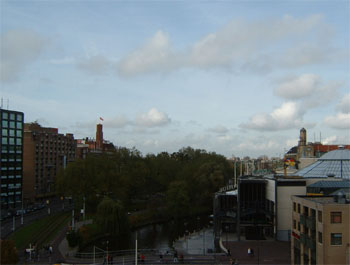
Copyright (c) 2004 Pourover Press